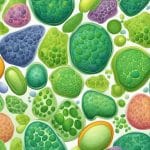Types Of Enzymes
Enzymes are biological catalysts that facilitate chemical reactions in living organisms. They are essential to life and play a crucial role in various biological processes such as digestion, metabolism, and cellular respiration. Enzymes are proteins that are made up of long chains of amino acids. They are highly specific and can only catalyze a particular chemical reaction.
The structure of enzymes is fundamental to their function. Enzymes have an active site that binds to a specific substrate, which is the molecule that the enzyme acts on. The active site is a three-dimensional pocket or cleft that is formed by the folding of the protein chain. The shape of the active site is crucial to the specificity of the enzyme and determines which substrate it can bind to.
Key Takeaways
- Enzymes are biological catalysts that facilitate chemical reactions in living organisms.
- Enzymes are highly specific and can only catalyze a particular chemical reaction.
- The structure of enzymes is fundamental to their function, and the shape of the active site is crucial to the specificity of the enzyme.
Fundamentals of Enzyme Structure

Enzymes are biological catalysts that speed up chemical reactions in living organisms. They are made up of proteins that are composed of long chains of amino acids. The three-dimensional structure of enzymes is critical to their function.
Active Sites and Substrate Interaction
The active site of an enzyme is the region where the substrate molecule binds and the reaction takes place. The active site is usually a small pocket or cleft on the surface of the enzyme. The shape and chemical properties of the active site are complementary to those of the substrate molecule. This complementarity allows the substrate to bind to the active site with high specificity.
Enzyme Specificity and Induced Fit
Enzyme specificity is the ability of an enzyme to bind to a specific substrate molecule and catalyze a specific reaction. The lock and key model was proposed to explain the specificity of enzyme-substrate interactions. According to this model, the active site of an enzyme is rigid and complementary in shape to the substrate molecule, like a lock and key. However, this model was later replaced by the induced fit model, which suggests that the active site of an enzyme is flexible and changes shape upon substrate binding. This change in shape is induced by the binding of the substrate molecule and allows for more efficient catalysis.
Overall, the structure of enzymes is essential to their function. The active site and enzyme specificity allow for substrate recognition and efficient catalysis. The induced fit model explains the flexibility of the active site and the importance of substrate-induced conformational changes.
Enzyme Classification and Functions
Enzymes are classified based on the type of reaction they catalyze. There are six major classes of enzymes, each with a distinct function and mechanism. These classes are Oxidoreductases, Transferases, Hydrolases, Lyases, Ligases, and Isomerases.
Oxidoreductases and Transferases
Oxidoreductases are enzymes that catalyze redox reactions, transferring electrons from one molecule to another. Examples of oxidoreductases include alcohol dehydrogenase, which converts alcohols to aldehydes or ketones, and cytochrome c oxidase, which transfers electrons from cytochrome c to oxygen in the electron transport chain.
Transferases, on the other hand, transfer functional groups from one molecule to another. Examples of transferases include hexokinase, which transfers a phosphate group from ATP to glucose, and transaminases, which transfer amino groups from amino acids to alpha-keto acids.
Hydrolases, Lyases, and Ligases
Hydrolases are enzymes that catalyze the hydrolysis of chemical bonds. Examples of hydrolases include lipases, which break down lipids into fatty acids and glycerol, and amylases, which break down carbohydrates into simple sugars.
Lyases, on the other hand, break chemical bonds without the addition or removal of water. Examples of lyases include decarboxylases, which remove carboxyl groups from amino acids, and aldolases, which cleave carbon-carbon bonds.
Ligases, also known as synthetases, catalyze the formation of new chemical bonds. Examples of ligases include DNA ligase, which joins DNA fragments together, and ATP synthase, which synthesizes ATP from ADP and phosphate.
Isomerases and Additional Classes
Isomerases are enzymes that catalyze the conversion of one isomer to another. Examples of isomerases include triose phosphate isomerase, which converts dihydroxyacetone phosphate to glyceraldehyde 3-phosphate, and phosphoglucomutase, which converts glucose 1-phosphate to glucose 6-phosphate.
In addition to the six major classes of enzymes, there are several additional classes that catalyze unique reactions. For example, proteases catalyze the hydrolysis of peptide bonds in proteins, and phosphatases remove phosphate groups from molecules.
Overall, enzymes play a crucial role in biological processes by catalyzing chemical reactions that would otherwise occur too slowly to sustain life. By understanding the classification and functions of enzymes, scientists can better understand the mechanisms of various biochemical processes and develop new treatments for diseases.
Enzyme Kinetics and Catalysis
Enzymes are biological catalysts that increase the rate of chemical reactions in living organisms. They do this by lowering the activation energy required for the reaction to occur. Enzymes are highly specific, meaning that they only catalyze specific reactions. The rate of an enzyme-catalyzed reaction is influenced by several factors, including temperature, pH, and the presence of inhibitors or activators.
Factors Affecting Enzyme Activity
Temperature and pH are two of the most important factors that affect enzyme activity. Enzymes have an optimal temperature and pH range in which they function best. Outside of this range, the enzyme’s activity decreases, and it may become denatured.
The rate of an enzyme-catalyzed reaction also depends on the concentration of the enzyme and substrate. At low substrate concentrations, the reaction rate increases with increasing substrate concentration until it reaches a maximum rate, known as Vmax. At this point, all of the enzyme’s active sites are saturated with substrate, and the reaction rate cannot increase further.
Inhibitors and activators can also affect enzyme activity. Inhibitors bind to the enzyme and reduce its activity, while activators increase the enzyme’s activity. Inhibitors can be competitive or non-competitive. Competitive inhibitors bind to the active site of the enzyme, preventing the substrate from binding. Non-competitive inhibitors bind to a site on the enzyme other than the active site, causing a conformational change that reduces the enzyme’s activity.
Catalytic Mechanisms
Enzymes catalyze reactions through several mechanisms, including covalent catalysis and acid-base catalysis. In covalent catalysis, the enzyme forms a covalent bond with the substrate, lowering the energy required for the reaction to occur. In acid-base catalysis, the enzyme acts as an acid or base, donating or accepting protons to facilitate the reaction.
Enzymes also stabilize the transition state of the reaction, which is the highest energy state in the reaction pathway. By stabilizing the transition state, enzymes lower the activation energy required for the reaction to occur, increasing the reaction rate.
In summary, enzymes play a critical role in biological processes by catalyzing reactions and increasing the rate of chemical reactions. The rate of enzyme-catalyzed reactions is influenced by several factors, including temperature, pH, and the presence of inhibitors or activators. Enzymes catalyze reactions through several mechanisms, including covalent catalysis and acid-base catalysis, and stabilize the transition state of the reaction, lowering the activation energy required for the reaction to occur.
Enzyme Regulation and Inhibition
Enzymes are protein molecules that catalyze specific chemical reactions in the body. They are essential for many physiological functions, including digestion, metabolism, and cellular signaling. Enzyme activity is regulated by a variety of mechanisms, including cofactors, coenzymes, and inhibitors.
Allosteric Control and Covalent Modification
Allosteric control is a mechanism by which the activity of an enzyme is regulated by binding of a molecule to a site on the enzyme that is distinct from the active site. This binding can either activate or inhibit the enzyme. Covalent modification is another mechanism by which enzyme activity can be regulated. This involves the addition or removal of a chemical group to the enzyme, which can alter its activity.
Inhibitor Types and Their Effects
Inhibitors are molecules that decrease the activity of an enzyme. There are two main types of inhibitors: competitive and non-competitive. Competitive inhibitors bind to the active site of the enzyme, preventing the substrate from binding. Non-competitive inhibitors bind to a site on the enzyme other than the active site, causing a conformational change that reduces the enzyme’s activity.
Inhibitors can be reversible or irreversible. Reversible inhibitors can bind and unbind from the enzyme, while irreversible inhibitors form a permanent bond with the enzyme, rendering it inactive. Some inhibitors are natural products, such as toxins and poisons, while others are synthetic compounds used as drugs.
Overall, enzyme regulation and inhibition are important mechanisms for controlling physiological processes in the body. Understanding these mechanisms can lead to the development of new drugs and therapies for a variety of diseases.
Enzymes in Biological Processes
Enzymes are essential for the proper functioning of biological processes. They catalyze reactions and regulate metabolic pathways, without which most of these processes would not occur at a perceptible rate. Enzymes are proteins that act as biological catalysts by accelerating chemical reactions. They have highly specific active sites that bind to specific substrates, and convert them into different molecules known as products.
Digestive Enzymes
Digestive enzymes are enzymes that break down food into smaller molecules that can be absorbed and used by the body. These enzymes are produced in the digestive system and are essential for proper digestion. The major digestive enzymes include amylase, trypsin, lactase, and pepsin.
Amylase is an enzyme that breaks down carbohydrates into simple sugars. It is produced in the salivary glands and pancreas, and is essential for the digestion of starches.
Trypsin is an enzyme that breaks down proteins into amino acids. It is produced in the pancreas and is essential for the digestion of proteins.
Lactase is an enzyme that breaks down lactose, a sugar found in milk, into glucose and galactose. It is produced in the small intestine and is essential for the digestion of lactose.
Pepsin is an enzyme that breaks down proteins in the stomach. It is produced in the stomach and is essential for the digestion of proteins.
Metabolic Pathways
Enzymes play a crucial role in metabolic pathways, which are the chemical reactions that occur in cells to maintain life. They are involved in processes such as respiration, energy production, and the breakdown of nutrients.
In respiration, enzymes are involved in the breakdown of glucose to produce energy. The major enzyme involved in this process is ATP synthase, which produces ATP, the energy currency of the cell.
Enzymes are also involved in the breakdown of nutrients such as fats and carbohydrates. Lipase is an enzyme that breaks down fats into fatty acids and glycerol, while amylase breaks down carbohydrates into simple sugars.
In conclusion, enzymes are essential for the proper functioning of biological processes. They are involved in processes such as digestion, metabolism, respiration, and energy production. Enzymes have highly specific active sites that bind to specific substrates, and convert them into different molecules known as products.






